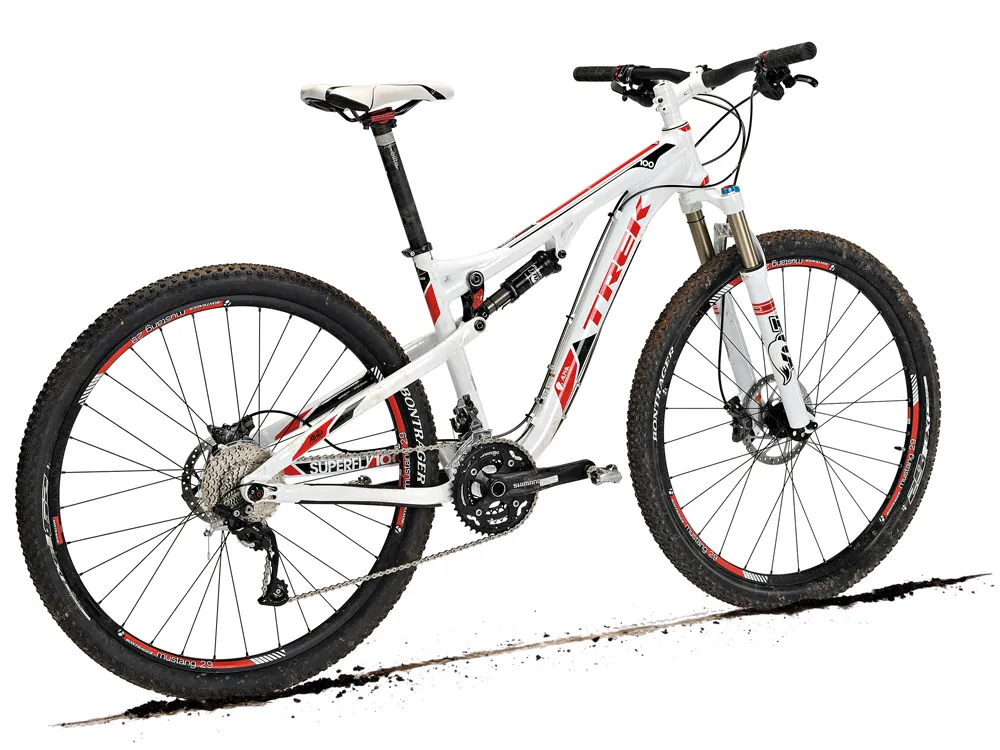Arguably the most significant feature of Trek’s Superfly 100 AL Elite is tucked away behind the seat tube. It’s a Gary Fisher signature decal, signifying that this bike is, in genesis at least, the inspiration of one of mountain biking’s founding fathers – and the inventor of the 29er concept.
The AL Elite props up the bottom of the five-strong, 29in-wheeled Superfly 100 range, offering a trail-worthy spec at a price that just creeps over the magic £2k barrier. Great handling, sorted suspension performance, decent components and epic mud clearance make for big-wheeled trail fun. The Trek looks a tiny bit pricey compared to some of the competition, though.
Ride & handling: Fast rolling, great handling trail machine that’ll tackle anything you can throw at it
Big wheels only really look in proportion when they’re connected to a big frame. So our 17.5in test bike, in common with most 29ers around this size, has that slightly disconcerting effect of looking… well, not quite right at first glance. It’s only because we’re all used to smaller wheels, and we only mention it because that ‘not quite right’ feeling disappears the moment you climb aboard the Trek and turn the pedals.
From just-so weight distribution to a wheelbase that’s pretty much the identical twin of 26in-wheeled competitors and a front wheel that goes where you want it to, the Superfly 100 will have uninitiated riders forgetting about the big wheels within the first few minutes. Which is, when you think about it, about the biggest compliment we can pay it. Get on, ride, and enjoy the easy-rolling nature of 29er wheels.
Fox shocks with a high compression damping tune can make a bike feel constipated over small bumps. Not here. The big wheels certainly help, but the Superfly’s suspension remains supple and controlled on everything from technical climbs to flat-out descents. If we were to split hairs, we’d suggest that the front end is a tiny bit slower to respond in fast-changing situations, but that’s the laws of physics for you – more rotating mass, further from the centre of the wheel. There’s nothing anyone – not even Gary Fisher himself – can do about that.
Big wheels with 100mm of travel translate into fast, efficient and comfortable mile-munching. We’ve known that for a while, but what the Superfly 100 does so well is to iron out all the little niggles that have beset earlier attempts at big wheeled full-suspension nirvana. The geometry works, the handling is excellent, the weight is reasonable in an unexceptional kind of a way and there’s even decent mud clearance. Is it the best 29er full-susser available? No. But it’s well worth putting on your shortlist.
Frame & equipment: We wish the frame finish was a bit neater, particularly around the welded areas
Cramming big wheels into a bike offering 100mm of travel at each end isn’t straightforward. There’s less space for most components, a greater need to pay attention to geometry and a number of stiffness-related issues to deal with. Trek’s design team have been sweating the details, resulting in a frame that’s bristling with mostly subtle design solutions.
Fitting the frame tubes into the available space is arguably one of their less successful achievements, the conjoined top and down tubes necessitating large – and, it has to be said, not particularly tidy – welds. Never mind that, though, because all the functional stuff has been taken care of.
Trek’s Active Braking Point (ABP) pivot – which places the chainstay pivot around the hub’s rear axle – is here in versatile ‘Convert’ form, meaning that the standard 135x5mm rear axle can be switched to a stiffer, lighter 142x12mm design at a later date. A Bontrager-designed hub with widened, bigger diameter flanges and larger dropout contact area performs the same job up front.
The Superfly 100’s fork uses a crown with increased offset, which reduces trail (the distance between the front tyre’s contact point on the ground and the point where a straight line through the centre of the head tube also meets the ground) and sharpens steering responses, countering the 29er tendency to be slow-handling in the turns. Carefully shaped stays wrap cleverly around the rear tyre, giving this bike the best mud clearance we’ve yet seen on a big wheeled machine.
In common with many full-suspension designs the Superfly 100 struggles to accommodate a pair of standard bottle cage bosses. There’s one set in the usual place on top of the down tube but the second set has been shunted into a position right in line with the spray off the front wheel, under the down tube. You could put a bottle there, but you probably wouldn’t want to.
A Fox Float RP2 shock matches the fork nicely and clip-on sag indicators make the job of getting the right air pressure front and rear straightforward. Predominantly Shimano SLX-based components work well and should prove reliable and Bontrager finishing kit is all top-notch, although we’d swap the tyres for something with more grip if you ride a lot in wet conditions.

This article was originally published in What Mountain Bike magazine.
